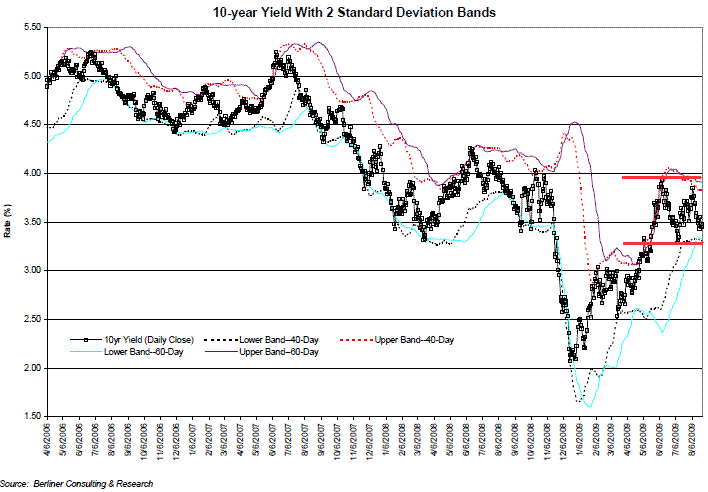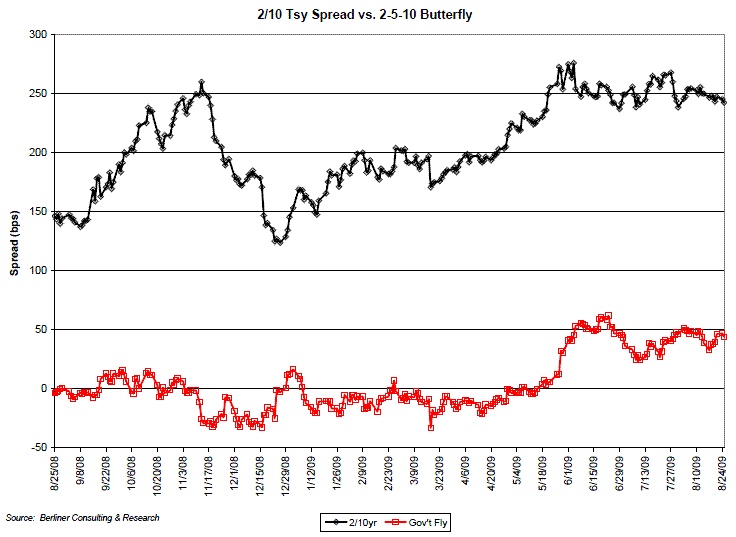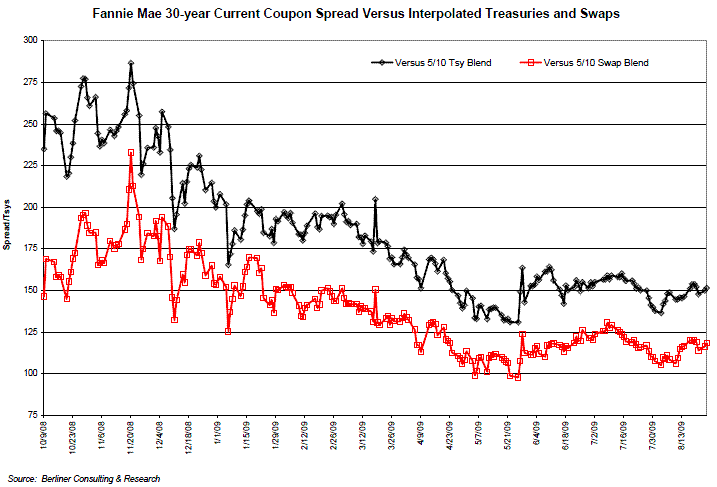Levels in the capital markets appeared to have stabilized over the past few months. Treasury yields have remained in a fairly tight range, as have yield spreads for mortgage-backed securities.
In particular, MBS yield spreads have remained quite stable since mid-June. The spread of the Fannie Mae current coupon over the interpolated 5-10 Treasury has ranged from a low of +137 basis points to a wide of +164. Currently it is above its 60-day average at +152 bps. While yields and spreads have been strongly impacted by the Fed’s purchase programs, I believe that spreads over the remainder of 2009 and into next year will be impacted by changes in the Fed’s monetary policies and its affect on the shape of the Treasury yield curve.
Chart 1 indicates that the yield on the 10-year Treasury is now stuck in the midpoint of a range which is roughly defined as between a floor of about 3.30% and an upper range of around 3.90-3.95%. The range began to be defined in late May/early June, and has held up despite the issuance of hundreds of billions of dollars worth of new securities (including, since May, almost $90 billion in 10-years).

It’s also notable that, since late May, the configuration of the yield curve has changed little. As Chart 2 indicates, the spread between the 2- and 10-year Treasuries has stabilized between +240 and 260 basis points, after peaking at an all-time high of +275 on May 27th. The middle (or “belly”) of the curve has also stabilized since late May. The so-called 2yr-5yr-10yr butterfly has steadied at around +50 basis points, indicating that the yield curve is positively “bowed” or convex. Last fall, the butterfly was slightly negative, indicating that the curve was concave (i.e., that the yield on the 5-year was below a straight-line interpolation between 2s and 10s).
The shape of the yield curve has a number of effects on investors, especially MBS holders. Some observers look at the curve’s shape as a leading indicator of economic activity. I think that this may work in normal times; to state the obvious, however, these times are not normal. Short rates are currently dictated almost entirely by the Fed, which seems to be in no hurry to raise rates from their current point of zero. The longer end of the curve (i.e., 10s and longer) has a number of factors weighing on it (inflation fears, economic uncertainty, the looming cessation of Fed purchases, supply, etc.), although none of them have proven strong enough to push Treasury yields out of their recent range.
The shape of the yield curve does have a major impact on mortgage and MBS valuations for a number of technical reasons. In valuation models, each cash flow of a security is discounted at a rate implied by the yield curve (using so-called forward interest rates). In addition, a steeper yield curve implies higher interest rates in the future. All things equal, higher implied future yields translate into slow prepayment speeds, which in turn impact MBS yields and durations (and prices!).
As shown in the attached chart, MBS spreads (versus both Treasuries and swaps) have been steady since mid-June. Given the importance that the curve has on MBS valuations, investors (and those whose businesses are based on MBS pricing...originators and borrowers for example) need to be concerned with changes in the curve’s configuration. The operative questions are: when will the yield curve shift, what might trigger a shift, and how will the curve’s configuration change (i.e., steeper or flatter)? 
What does this mean for mortgage rates?
MBS levels and mortgage rates take a fair amount of guidance from the shape of the yield curve. My view is that changes in the shape of the curve, and thus mortgage rates, will be driven by the timing of any move by the Fed, as much as the magnitude of the move itself.
If the Fed appears to be proactive in tightening policy (including raising short rates) before signs of inflation and/or supply indigestion begins to develop, the curve could flatten sharply (to inside of +150) and mortgage rates would fall. However, if the Fed looks to be delinquent in tightening credit, you could see long rates shoot up while short rates remain pegged around their current levels. This could result in a yield curve spread (2s versus 10s) of +300 or more, and thus higher mortgage rates.
While my crystal ball is currently in the shop, I believe that the latter scenario is more likely to play out, especially when considering the political factors at play (i.e., politicians like lower rates), the end of the Fed's MBS purchase program, and fears of a double-dip recession. If this happens, a sharply steeper yield curve will weigh on MBS valuations and cause MBS spreads to widen, and ultimately push mortgage rates higher. The timing of this is tough to forecast, since the scenario implies that the Fed’s hand will be forced by market factors; if I were to guess, I’d expect it by the end of the first quarter of 2010.
Bill Berliner is a mortgage and capital-markets consultant based in Southern California. His last corporate position was as the head of trade strategies for Countrywide Capital Markets’ highly-regarded Research department. He is the co-author, with Frank Fabozzi and Anand Bhattacharya, of "Mortgage-Backed Securities: Products, Structuring, and Analytical Techniques," which was named one of the top ten finance books of 2007 by RiskBooks.
To read more on Bill's research visit www.FixedIncomeColor.com





